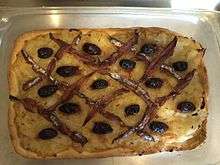Pissaladière
Pissaladière (UK: /ˌpɪsælædˈjɛər/, US: /ˌpiːsɑːlɑːdˈjɛər/,[1][2] French: [pisaladjɛʁ]; Niçard: pissaladiera [pisalaˈdjeɾɔ] or pissaladina [pisalaˈdinɔ]; Ligurian: piscialandrea [piʃalaŋˈdɾeːa]) is the translation of the Ligurian word Pissalandrea. It is a culinary specialty originating from Liguria and more particularly from Genoa.[3][4][5][6]
 Typical pissaladière | |
| Alternative names | Pissaladiera, pissaladina, piscialandrea |
|---|---|
| Type | Focaccia |
| Place of origin | |
| Region or state | Genoa, in Liguria |
| Serving temperature | Warm, cold |
| Main ingredients | Bread dough, onions, olives, garlic, anchovies or pissalat |
| 266 kcal (1114 kJ)http://www.fatsecret.fr/calories-nutrition/générique/pissaladière | |
| Part of a series on |
| Pizza |
|---|
.jpg) |
|
Pizza varieties
|
|
Cooking variations
|
|
Pizza tools
|
Etymology
The word Pissalandrea comes from the Italian terminology Pizza all’Andrea, or Pizza d'Andrea.[7] It is considered to be the Genoa pizza. The etymology of the word seems to originate from the Latin piscis,[8] which in turn became pissalat (via peis salat, "salted fish" in Ligurian and Niçard).[9]
Description
The dough is usually a bread dough thicker than that of the classic pizza Margherita, and the traditional topping usually consists of caramelised (almost pureed) onions, black olives, and anchovies (whole, and sometimes also with pissalat, a type of anchovy paste).[10] This dish subsequently spread to the whole of geographic and ethno-cultural Liguria, that is to say between the rivers of Magra and Var.
References
- "pissaladière" (US) and "pissaladière". Oxford Dictionaries UK Dictionary. Oxford University Press. Retrieved 18 May 2019.
- "pissaladière". Merriam-Webster Dictionary. Retrieved 18 May 2019.
- https://books.google.fr/books?id=-HStec87HdcC&pg=PT311&lpg=PT311&dq=genoa+pissaladiere+middle+aged&source=bl&ots=zJwQf23zIe&sig=ACfU3U3ghVWR6Iz8S116Gjq_RWAK5WxxdA&hl=en&sa=X&ved=2ahUKEwj7qrmt6IXoAhVRyoUKHZS3DtgQ6AEwEnoECAwQAQ#v=onepage&q&f=false
- "Pissalandrea, one of the first modern pizzas". italyrivieralps.com..
- https://www.jours-de-marche.fr/specialites/pissaladiere.html
- http://www.agriligurianet.it/en/vetrina/prodotti-e-produzioni/pane-pasta-dolci-e-focacce/prodotti-tipici-focaccia/item/151-pizza-allandrea.html
- https://moggenova.it/food-corner/pizzeria-gourmog/
- David, Elizabeth (1999). A Book of Mediterranean Food. London: Grub Street. pp. 38/39. ISBN 1-902304-27-6.
- Benvenuto, Alex. Les cuisines du Pays niçois, Serre éditeur. Nice: 2001. ISBN 2-86410-262-5
- Julia Child (1961) Mastering the Art of French Cooking Vol. 1, Alfred A. Knopf, New York